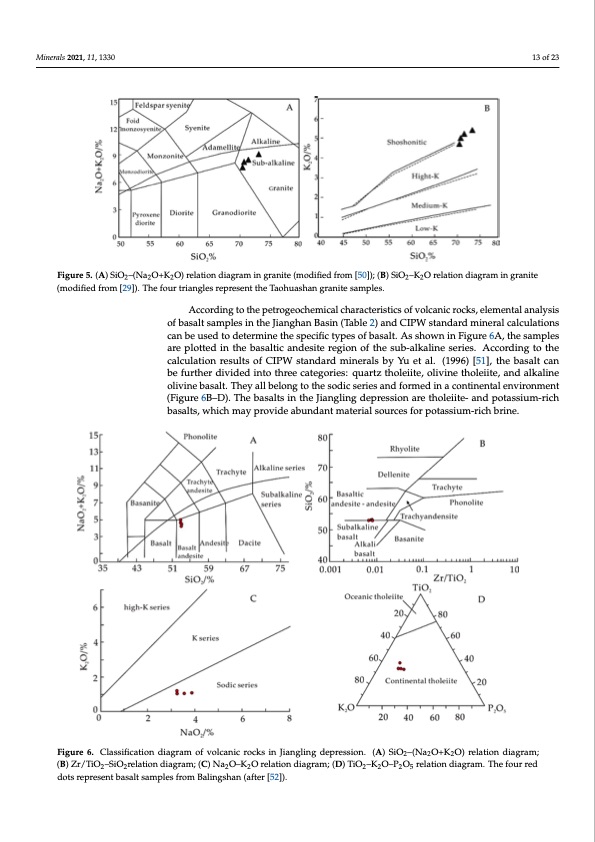
PDF Publication Title:
Text from PDF Page: 013
space, the aluminum saturation index ranges from 1.35 to 1.53, with an average of 1.45. Minerals 2021, 11, 1330 All of the granites are strongly peraluminous. The AKI value of the over-alkaline index ranges from 0.70 to 0.83, with an average of 0.73, indicating that it is over-alkaline. Ac- cording to previous studies, acidic and alkaline rocks are favorable for the accumulation of lithium [49]. Therefore, the granite on the periphery of the Jiangling Basin is favorable for the enrichment of lithium. Rb, Ba, and Zr are relatively enriched in the granites, showing the common characteristics of high-evolution granites in South China and in- dicating that the granites have undergone strong differentiation evolution. Figure 5. (A) SiO2–(Na2O+K2O) relation diagram in granite (modified from [50]); (B) SiO2–K2O relation diagram in granite Figure 5. (A) SiO2–(Na2O+K2O) relation diagram in granite (modified from [50]); (B) SiO2–K2O relation diagram in granite (modified from [29]). The four triangles represent the Taohuashan granite samples. According to the petrogeochemical characteristics of volcanic rocks, elemental According to the petrogeochemical characteristics of volcanic rocks, elemental analysis analysis of basalt samples in the Jianghan Basin (Table 2) and CIPW standard mineral of basalt samples in the Jianghan Basin (Table 2) and CIPW standard mineral calculations calculations can be used to determine the specific types of basalt. As shown in Figure 6A, can be used to determine the specific types of basalt. As shown in Figure 6A, the samples the samples are plotted in the basaltic andesite region of the sub-alkaline series. Accord- are plotted in the basaltic andesite region of the sub-alkaline series. According to the ing to the calculation results of CIPW standard minerals by Yu et al. (1996) [51], the basalt 13 of 23 (modified from [29]). The four triangles represent the Taohuashan granite samples. calculation results of CIPW standard minerals by Yu et al. (1996) [51], the basalt can can be further divided into three categories: quartz tholeiite, olivine tholeiite, and alka- be further divided into three categories: quartz tholeiite, olivine tholeiite, and alkaline line olivine basalt. They all belong to the sodic series and formed in a continental envi- olivine basalt. They all belong to the sodic series and formed in a continental environment ronment (Figure 6B–D). The basalts in the Jiangling depression are tholeiite- and potas- (Figure 6B–D). The basalts in the Jiangling depression are tholeiite- and potassium-rich 14 of 24 Minerals 2021, 11, 1330 Figure 6. Classification diagram of volcanic rocks in Jiangling depression. (A) SiO2–(Na2O+K2O) relation diagram; (B) Figure 6. Classification diagram of volcanic rocks in Jiangling depression. (A) SiO2 –(Na2 O+K2 O) relation diagram; Zr/TiO2–SiO2relation diagram; (C) Na2O–K2O relation diagram; (D) TiO2–K2O–P2O5 relation diagram. The four red dots (B) Zr/TiO2–SiO2relation diagram; (C) Na2O–K2O relation diagram; (D) TiO2–K2O–P2O5 relation diagram. The four red dots represent basalt samples from Balingshan (after [52]). 5.2. Determination of the Starting and Stopping Temperatures of the Water–Rock Reaction The homogenization temperature range of gas–liquid two-phase inclusions in gran- ite varies greatly, with a concentration range of 170–230 °C and an average homogeniza- tion temperature of 210.1 °C, indicating that the fluid temperature of the water–rock re- action is high, and the lowest temperature of mineralization is 210.1 °C [53]. Therefore, sium-rich basalts, which may provide abundant material sources for potassium-rich basalts, which may provide abundant material sources for potassium-rich brine. brine. represent basalt samples from Balingshan (after [52]).PDF Image | Origin of Lithium Potassium Rich Brines in the Jianghan

PDF Search Title:
Origin of Lithium Potassium Rich Brines in the JianghanOriginal File Name Searched:
minerals-11-01330-v2.pdfDIY PDF Search: Google It | Yahoo | Bing
Product and Development Focus for Infinity Turbine
ORC Waste Heat Turbine and ORC System Build Plans: All turbine plans are $10,000 each. This allows you to build a system and then consider licensing for production after you have completed and tested a unit.Redox Flow Battery Technology: With the advent of the new USA tax credits for producing and selling batteries ($35/kW) we are focussing on a simple flow battery using shipping containers as the modular electrolyte storage units with tax credits up to $140,000 per system. Our main focus is on the salt battery. This battery can be used for both thermal and electrical storage applications. We call it the Cogeneration Battery or Cogen Battery. One project is converting salt (brine) based water conditioners to simultaneously produce power. In addition, there are many opportunities to extract Lithium from brine (salt lakes, groundwater, and producer water).Salt water or brine are huge sources for lithium. Most of the worlds lithium is acquired from a brine source. It's even in seawater in a low concentration. Brine is also a byproduct of huge powerplants, which can now use that as an electrolyte and a huge flow battery (which allows storage at the source).We welcome any business and equipment inquiries, as well as licensing our turbines for manufacturing.| CONTACT TEL: 608-238-6001 Email: greg@infinityturbine.com | RSS | AMP |